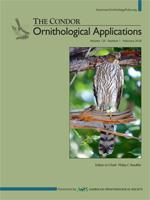Understanding spatial connectivity of long-distance migrants is important for effective management and conservation of both game and nongame species. Hunting of Nearctic-breeding shorebirds occurs in the Caribbean and northern South America; however, the origins of harvested individuals are generally unknown. We used stable hydrogen isotopes (δ2H) in feathers of juvenile shorebirds to infer the origins of birds harvested at 2 sites in Barbados using probabilistic assignments based on a terrestrial–freshwater δ2H isoscape. We used tissue δ13C and δ15N values to filter individuals that had derived nutrients from marine sources. Natal origins of juvenile American Golden-Plover (Pluvialis dominica), Stilt Sandpiper (Calidris himantopus), Short-billed Dowitcher (Limnodromus griseus), and Lesser Yellowlegs (Tringa flavipes) were predicted to be mainly from the eastern parts of their breeding ranges in eastern Canada, with American Golden-Plover, Stilt Sandpiper, and Short-billed Dowitcher also having high potential areas of origin in parts of Alaska, USA. Results from our study should help to modify prior estimates of sustainable harvest levels for these species. We identify sources of uncertainty in determining shorebird origins using stable isotopes, including a lack of shorebird-specific calibration equations and the apparent lack of an appropriate tissue for breeding ground assignment for adults.
How to translate text using browser tools
18 April 2018
Shorebird hunting in Barbados: Using stable isotopes to link the harvest at a migratory stopover site with sources of production
Eric T. Reed,
Kevin J. Kardynal,
Julia A. Horrocks,
Keith A. Hobson

The Condor
Vol. 120 • No. 2
May 2018
Vol. 120 • No. 2
May 2018
carbon-13
deuterium
fall migration
harvested species
migratory connectivity
nitrogen-15
Shorebirds




